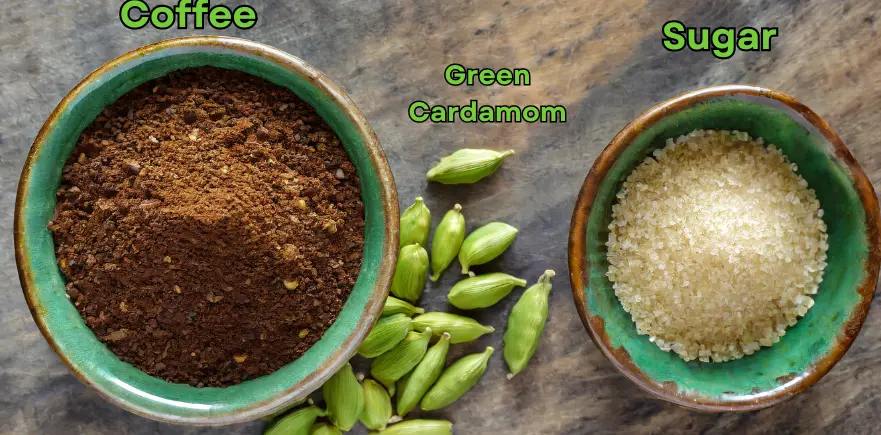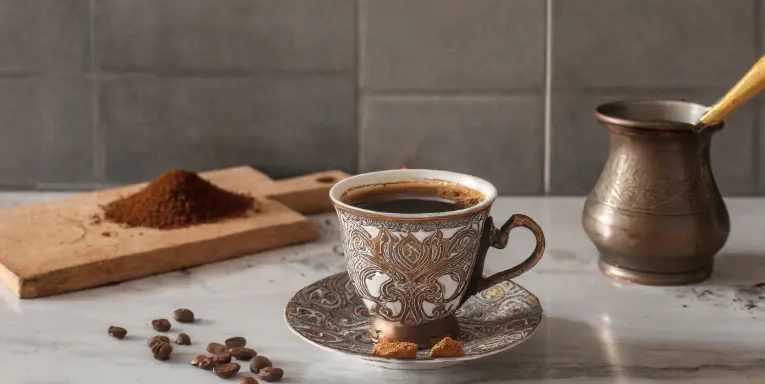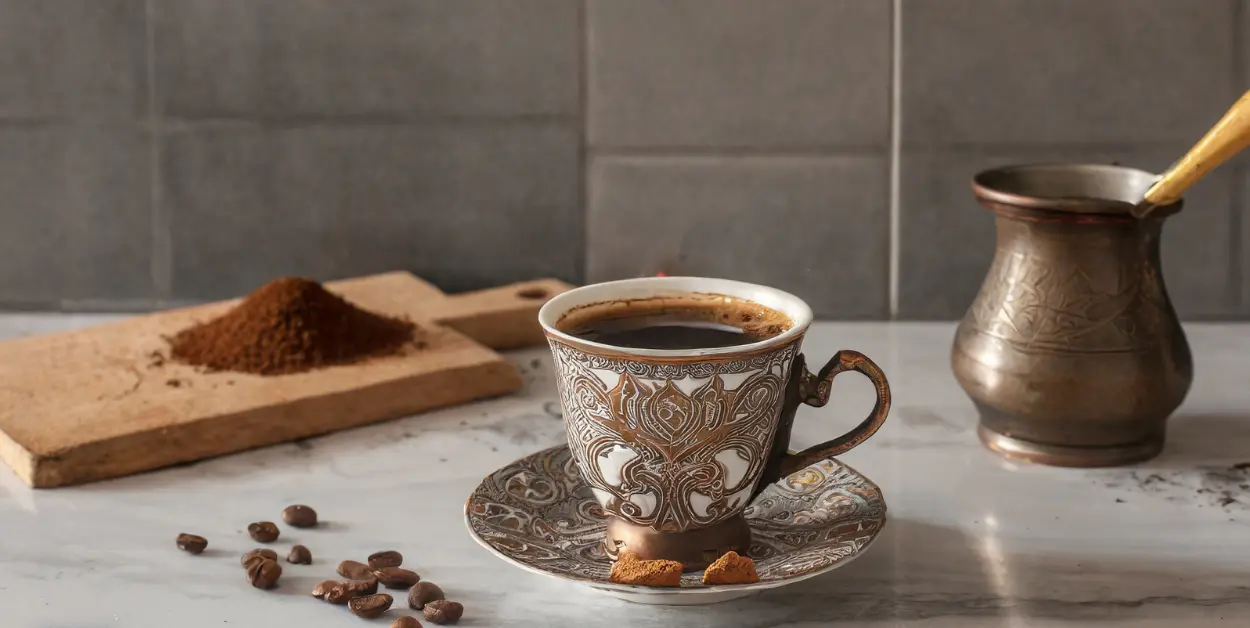Armenian coffee is more than just a beverage – it’s a cultural institution that has been bringing people together for centuries. Similar to Turkish or Greek coffee, this rich, aromatic preparation stands out for its distinctive brewing technique and serving traditions that have been passed down through generations.
The slow brewing process creates a uniquely intense flavor profile and velvety texture that’s impossible to achieve with modern brewing methods.
What makes Armenian coffee truly special is the importance it holds in social gatherings. Traditionally served after meals or during social visits, the coffee becomes a centerpiece for conversation and connection.
The art of preparing and serving Armenian coffee is considered a sign of hospitality and respect in Armenian culture. Learning to make this coffee isn’t just about following a recipe – it’s about embracing a ritual that has deep cultural significance.
Quick Information
- Prep Time: 5 minutes
- Cook Time: 10 minutes
- Total Time: 15 minutes
- Servings: 2 people
- Difficulty: Easy
Nutrition Information (per serving)
| Nutrient | Amount |
|---|---|
| Calories | 15 |
| Carbohydrates | 1g |
| Protein | 1g |
| Fat | 0g |
| Sugar | 0g |
| Sodium | 5mg |
| Caffeine | 80-100mg |

History of Armenian Coffee
Armenian coffee has a rich history that spans centuries, with its roots tracing back to the Ottoman Empire period. Coffee was introduced to Armenia through trade routes connecting the Middle East with Eastern Europe and quickly became integral to the social fabric of Armenian society.
During times of Ottoman rule, coffee houses emerged as important social hubs where people would gather to discuss politics, business, and community matters. The tradition of preparing coffee in a special pot called a jazve (also known as a cezve) developed during this period and has remained largely unchanged for hundreds of years.
What distinguishes Armenian coffee preparation from other methods is the particular attention to detail in the brewing process. Unlike Turkish coffee which is often served with high foam, Armenian coffee traditionally aims for a more moderate foam with emphasis on the rich flavor profile. The coffee is typically accompanied by a glass of cold water to cleanse the palate before drinking, allowing the drinker to fully appreciate the complex flavors.
An interesting cultural aspect of Armenian coffee is coffee fortune telling, a tradition where the patterns left by the grounds at the bottom of the cup are interpreted to predict the drinker’s future. This practice, known as tasseography, remains popular at family gatherings and among friends, adding another layer of significance to the coffee drinking experience.
Ingredients
For authentic Armenian coffee, you’ll need just a few simple ingredients, but the quality of each component matters significantly:
- 2 heaping teaspoons of extra-fine ground Armenian or Arabic coffee (alternatively, you can use any dark roast coffee ground to an extremely fine powder)
- 2 cups of cold, filtered water
- Sugar to taste (traditionally varies from none to 2 teaspoons per serving)
- Cardamom (optional, about 1/4 teaspoon ground)
The coffee grounds should be so fine that they resemble powder rather than the typical grounds used for drip coffee. This ultra-fine grind is essential for creating the proper texture and flavor profile that defines Armenian coffee.

Check also – Top Coffee Makers of the Year: Brew the Perfect Cup at Home
Equipment Needed
To prepare Armenian coffee properly, you’ll need some specific equipment:
- Armenian coffee pot (jazve/cezve) – a small, long-handled pot typically made of copper, brass, or stainless steel with a wide bottom and narrow top
- Small coffee cups (similar to espresso cups but with slightly different shape)
- A heat source – gas stove works best for controlling the heat precisely
- A small spoon for stirring
- Coffee grinder capable of extremely fine grinding (if you’re grinding your own beans)
The traditional vessel used for brewing Armenian coffee is crucial to achieving authentic results. The unique shape of the jazve allows for proper heat distribution and the formation of the characteristic foam on top of the coffee.
Step-by-Step Instructions
Preparing the Coffee Mixture
- Measure the cold water using the coffee cups you’ll be serving in. Pour this water into the jazve.
- Add the finely ground coffee to the water in the jazve. The proportion should be approximately one heaping teaspoon of coffee grounds per cup of water.
- Add sugar according to preference. In Armenian tradition, coffee is often categorized by sweetness:
- Sade (plain): No sugar
- Az shekerli (little sugar): Half a teaspoon per cup
- Orta shekerli (medium sweet): One teaspoon per cup
- Shekerli (sweet): Two teaspoons per cup
- If using cardamom, add it now. This spice adds a distinctive aroma and flavor that complements the coffee beautifully.
- Do not stir yet. Allow the coffee grounds to float on the surface of the water.
The Brewing Process
- Place the jazve on your heat source at low heat. The key to perfect Armenian coffee is slow, steady heating.
- As the water gradually warms, the coffee grounds will begin to sink. At this point, stir the mixture gently to ensure even distribution of grounds and sugar.
- Watch the coffee carefully as it heats. Never leave it unattended, as the next steps require precise timing.
- As the coffee heats, a dark foam will begin to form around the edges of the pot. This foam is crucial for authentic Armenian coffee.
- Just before the coffee comes to a boil, when the foam begins to rise, remove the jazve from the heat and allow the foam to subside.
- Return the jazve to the heat source. This time, allow the coffee to rise more substantially, almost to the point of boiling over, then remove from heat again.
- For the most traditional preparation, repeat this process a third time. This triple heating method enhances the flavor complexity and creates the perfect foam.
- After the final heating, remove the jazve from the heat and tap it gently on the counter or lightly swirl it. This helps settle some of the grounds.
Serving the Coffee
- Pour the coffee slowly into the cups, distributing the foam evenly among them. The foam (called “kaymak”) is considered the mark of properly prepared coffee.
- Allow the coffee to sit for about 30 seconds before serving. This gives the grounds time to settle to the bottom of the cup.
- Serve each cup of coffee with a glass of cold water. The water is meant to be sipped before drinking the coffee to cleanse the palate.
- Traditional accompaniments include sweet treats like Armenian dried fruit sweets (sujukh), lokum (Turkish delight), or shortbread cookies.

Other Recipes
- Fudgy Protein Brownies That Taste Like Dessert but Fuel Your Goals
- How to Make Protein Iced Coffee That Boosts Energy and Builds Muscle
- Authentic Vietnamese Iced Coffee: Strong, Sweet, and Refreshing
- The Best Decaf Iced Coffee Recipes for a Chill Caffeine-Free Sip
- Easy Caramel Iced Coffee Recipe You Can Make at Home
- Homemade Toffee Nut Latte That Tastes Better Than the Coffee Shop
- How to Make Traditional Bosnian Coffee: A Rich and Cultural Brew
Tips for Perfect Armenian Coffee
- The quality of water matters significantly. Use filtered water for the cleanest taste.
- Never stir the coffee after it’s been poured into cups. The grounds need to settle at the bottom.
- When drinking, sip slowly and stop before reaching the grounds at the bottom of the cup.
- The finest grind possible is essential. If your coffee isn’t fine enough, the authentic experience will be compromised.
- The foam on top is not just for appearance – it adds to the mouthfeel and flavor experience. Take care to preserve it during the brewing process.
- Temperature control is crucial. Too hot, and you’ll burn the coffee; too cool, and it won’t develop the right flavor profile.
- Armenian coffee should be served immediately after preparation for the best taste and experience.
Common Mistakes to Avoid
- Using pre-ground coffee that isn’t fine enough. Standard espresso grind is not sufficient for Armenian coffee.
- Stirring too vigorously, which can break up the foam and distribute grounds throughout the coffee.
- Rushing the heating process. Armenian coffee requires patience and attention.
- Allowing the coffee to fully boil, which creates a bitter taste and destroys the delicate foam.
- Using too much coffee, which can make the brew overpoweringly strong and bitter.
- Washing the jazve with soap, which can leave residues that affect flavor. Instead, rinse with hot water and wipe clean.
Cultural Significance and Serving Traditions
In Armenian culture, coffee serving follows certain customs that enhance the experience:
- The oldest or most respected person at the gathering should be served first.
- Coffee is traditionally served on a tray, often with a small sweet treat on the side.
- The host typically prepares and serves the coffee personally as a sign of hospitality.
- After finishing, it’s customary to leave a small amount of coffee with the grounds in the cup, especially if participating in fortune telling.
- Complimenting the host on the quality of the coffee is a standard courtesy.
Variations and Modern Adaptations
While traditional Armenian coffee follows the method described above, several variations have developed over time:
- Adding spices like cinnamon or cloves to the brewing process for different flavor profiles.
- Creating a slightly less concentrated brew for those who prefer a milder coffee experience.
- Using specialized modern electric brewing devices designed specifically for Armenian or Turkish coffee.
- Cold Armenian coffee (rarely traditional but increasingly popular) where the brewed coffee is chilled and served over ice.
Conclusion
Armenian coffee represents more than just a caffeine boost – it embodies centuries of tradition, hospitality, and community. The meticulous preparation process and rich cultural significance make every cup an opportunity to connect with an ancient heritage.
By following this traditional method, you’ll create a coffee experience that engages all the senses – from the aromatic brewing process to the visually striking foam, the rich mouthfeel, and the complex flavor that lingers long after the last sip. Whether you’re exploring your Armenian roots or simply expanding your coffee horizons, mastering this brewing technique offers a rewarding journey into one of the world’s oldest coffee traditions.
Remember that like any traditional skill, perfect Armenian coffee comes with practice. Don’t be discouraged if your first attempts don’t produce the ideal foam or flavor balance. With patience and attention to detail, you’ll soon be brewing coffee that would make any Armenian grandmother proud.
So gather your ingredients, prepare your jazve, and embark on a coffee experience that transcends the ordinary. Your journey into the world of Armenian coffee awaits!
Recommended By BeautifulKitchenguide's Team
Amazon Must Have Kitchen Gadgets To Save Time Check List
Best Kitchen Faucets of 2025: Sleek, Durable & Worth Every PennyCheck Our Review
The Ultimate Guide to the Best Coffee Makers for Every Budget Check Our Review

